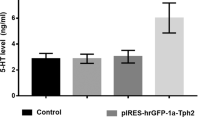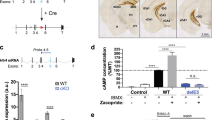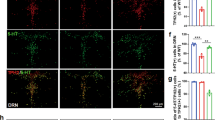Abstract
The association of single-nucleotide polymorphisms (SNPs) in the human tryptophan hydroxylase 2 (TPH2) gene with anxiety traits and depression has been inconclusive. Observed inconsistencies might result from the fact that TPH2 polymorphisms have been studied in a genetically heterogeneous human population. A defined genetic background, control over environmental factors, and the ability to analyze the molecular and neurochemical consequences of introduced genetic alterations constitute major advantages of investigating SNPs in inbred laboratory mouse strains. To investigate the behavioral and neurochemical consequences of a functional C1473G SNP in the mouse Tph2 gene, we generated congenic C57BL/6N mice homozygous for the Tph2 1473G allele. The Arg447 substitution in the TPH2 enzyme resulted in a significant reduction of the brain serotonin (5-HT) in vivo synthesis rate. Despite decreased 5-HT synthesis, we could detect neither a reduction of brain region-specific 5-HT concentrations nor changes in baseline and stress-induced 5-HT release using a microdialysis approach. However, using a [35S]GTP-γ-S binding assay and 5-HT1A receptor autoradiography, a functional desensitization of 5-HT1A autoreceptors could be identified. Furthermore, behavioral analysis revealed a distinct anxiety phenotype in homozygous Tph2 1473G mice, which could be reversed with chronic escitalopram treatment. Alterations in depressive-like behavior could not be detected under baseline conditions or after chronic mild stress. These findings provide evidence for an involvement of functional Tph2 polymorphisms in anxiety-related behaviors, which are likely not caused directly by alterations in 5-HT content or release but are rather due to compensatory changes during development involving functional desensitization of 5-HT1A autoreceptors.
Similar content being viewed by others
Log in or create a free account to read this content
Gain free access to this article, as well as selected content from this journal and more on nature.com
or
References
Alenina N, Kikic D, Todiras M, Mosienko V, Qadri F, Plehm R et al (2009). Growth retardation and altered autonomic control in mice lacking brain serotonin. Proc Natl Acad Sci USA 106: 10332–10337.
Anguelova M, Benkelfat C, Turecki G (2003). A systematic review of association studies investigating genes coding for serotonin receptors and the serotonin transporter: I. Affective disorders. Mol Psychiatry 8: 574–591.
APA (2000). Practice guideline for the treatment of patients with major depressive disorder (revision). American Psychiatric Association. Am J Psychiatry 157 (4 Suppl): 1–45.
Azmitia EC, Segal M (1978). An autoradiographic analysis of the differential ascending projections of the dorsal and median raphe nuclei in the rat. J Comparative Neurol 179: 641–667.
Beaulieu JM, Zhang X, Rodriguiz RM, Sotnikova TD, Cools MJ, Wetsel WC et al (2008). Role of GSK3 beta in behavioral abnormalities induced by serotonin deficiency. Proc Natl Acad Sci USA 105: 1333–1338.
Bielohuby M, Herbach N, Wanke R, Maser-Gluth C, Beuschlein F, Wolf E et al (2007). Growth analysis of the mouse adrenal gland from weaning to adulthood: time- and gender-dependent alterations of cell size and number in the cortical compartment. Am J Physiol 293: E139–E146.
Blier P, de Montigny C (1994). Current advances and trends in the treatment of depression. Trends Pharmacol Sci 15: 220–226.
Blier P, de Montigny C (1999). Serotonin and drug-induced therapeutic responses in major depression, obsessive-compulsive and panic disorders. Neuropsychopharmacology 21 (2 Suppl): 91S–98S.
Bouwknecht JA, Paylor R (2002). Behavioral and physiological mouse assays for anxiety: a survey in nine mouse strains. Behav Brain Res 136: 489–501.
Brinks V, van der Mark M, de Kloet R, Oitzl M (2007). Emotion and cognition in high and low stress sensitive mouse strains: a combined neuroendocrine and behavioral study in BALB/c and C57BL/6J mice. Frontiers Behav Neurosci 1: 8.
Brown SM, Peet E, Manuck SB, Williamson DE, Dahl RE, Ferrell RE et al (2005). A regulatory variant of the human tryptophan hydroxylase-2 gene biases amygdala reactivity. Mol Psychiatry 10: 884–888 805.
Calcagno E, Canetta A, Guzzetti S, Cervo L, Invernizzi RW (2007). Strain differences in basal and post-citalopram extracellular 5-HT in the mouse medial prefrontal cortex and dorsal hippocampus: relation with tryptophan hydroxylase-2 activity. J Neurochem 103: 1111–1120.
Canli T, Congdon E, Gutknecht L, Constable RT, Lesch KP (2005). Amygdala responsiveness is modulated by tryptophan hydroxylase-2 gene variation. J Neural Transm 112: 1479–1485.
Cervo L, Canetta A, Calcagno E, Burbassi S, Sacchetti G, Caccia S et al (2005). Genotype-dependent activity of tryptophan hydroxylase-2 determines the response to citalopram in a mouse model of depression. J Neurosci 25: 8165–8172.
Chourbaji S, Zacher C, Sanchis-Segura C, Dormann C, Vollmayr B, Gass P (2005). Learned helplessness: validity and reliability of depressive-like states in mice. Brain Res 16: 70–78.
Crowley JJ, Blendy JA, Lucki I (2005). Strain-dependent antidepressant-like effects of citalopram in the mouse tail suspension test. Psychopharmacology 183: 257–264.
De Luca V, Hlousek D, Likhodi O, Van Tol HH, Kennedy JL, Wong AH (2006). The interaction between TPH2 promoter haplotypes and clinical-demographic risk factors in suicide victims with major psychoses. Genes Brain Behav 5: 107–110.
Dulawa SC, Hen R (2005). Recent advances in animal models of chronic antidepressant effects: the novelty-induced hypophagia test. Neurosci Biobehav Rev 29: 771–783.
El Mansari M, Sanchez C, Chouvet G, Renaud B, Haddjeri N (2005). Effects of acute and long-term administration of escitalopram and citalopram on serotonin neurotransmission: an in vivo electrophysiological study in rat brain. Neuropsychopharmacology 30: 1269–1277.
Engblom D, Bilbao A, Sanchis-Segura C, Dahan L, Perreau-Lenz S, Balland B et al (2008). Glutamate receptors on dopamine neurons control the persistence of cocaine seeking. Neuron 59: 497–508.
Fabre V, Beaufour C, Evrard A, Rioux A, Hanoun N, Lesch KP et al (2000). Altered expression and functions of serotonin 5-HT1A and 5-HT1B receptors in knock-out mice lacking the 5-HT transporter. Eur J Neurosci 12: 2299–2310.
Fakra E, Hyde LW, Gorka A, Fisher PM, Munoz KE, Kimak M et al (2009). Effects of HTR1A C(-1019)G on amygdala reactivity and trait anxiety. Arch Gen Psychiatry 66: 33–40.
Froger N, Palazzo E, Boni C, Hanoun N, Saurini F, Joubert C et al (2004). Neurochemical and behavioral alterations in glucocorticoid receptor-impaired transgenic mice after chronic mild stress. J Neurosci 24: 2787–2796.
Fuss J, Ben Abdallah NM, Hensley FW, Weber KJ, Hellweg R, Gass P (2010). Deletion of running-induced hippocampal neurogenesis by irradiation prevents development of an anxious phenotype in mice. PloS One 5: e12769.
Garriock HA, Allen JJ, Delgado P, Nahaz Z, Kling MA, Carpenter L et al (2005). Lack of association of TPH2 exon XI polymorphisms with major depression and treatment resistance. Mol Psychiatry 10: 976–977.
Griebel G, Belzung C, Perrault G, Sanger DJ (2000). Differences in anxiety-related behaviours and in sensitivity to diazepam in inbred and outbred strains of mice. Psychopharmacology 148: 164–170.
Gross C, Zhuang X, Stark K, Ramboz S, Oosting R, Kirby L et al (2002). Serotonin1A receptor acts during development to establish normal anxiety-like behaviour in the adult. Nature 416: 396–400.
Gutknecht L, Jacob C, Strobel A, Kriegebaum C, Muller J, Zeng Y et al (2007). Tryptophan hydroxylase-2 gene variation influences personality traits and disorders related to emotional dysregulation. Int J Neuropsychopharmacol/Offl Scientific J Collegium Internationale Neuropsychopharmacologicum (CINP) 10: 309–320.
Haghighi F, Bach-Mizrachi H, Huang YY, Arango V, Shi S, Dwork AJ et al (2008). Genetic architecture of the human tryptophan hydroxylase 2 gene: existence of neural isoforms and relevance for major depression. Mol Psychiatry 13: 813–820.
Herrnstein RJ (1961). Relative and absolute strength of response as a function of frequency of reinforcement. J Exp Anal Behav 4: 267–272.
Hoff J (2000). Methods of blood collection in the mouse. Lab Animal 29: 47–53.
Isles AR, Hathway GJ, Humby T, de la Riva C, Kendrick KM, Wilkinson LS (2005). An mTph2 SNP gives rise to alterations in extracellular 5-HT levels, but not in performance on a delayed-reinforcement task. Eur J Neurosci 22: 997–1000.
Jacobsen JP, Nielsen EO, Hummel R, Redrobe JP, Mirza N, Weikop P (2008). Insensitivity of NMRI mice to selective serotonin reuptake inhibitors in the tail suspension test can be reversed by co-treatment with 5-hydroxytryptophan. Psychopharmacology 199: 137–150.
Jacobsen JP, Siesser WB, Sachs BD, Peterson S, Cools MJ, Setola V et al (2011). Deficient serotonin neurotransmission and depression-like serotonin biomarker alterations in tryptophan hydroxylase 2 (Tph2) loss-of-function mice. Mol Psychiatry; e-pub ahead of print 3 May 2011.
Johnson DA, Grant EJ, Ingram CD, Gartside SE (2007). Glucocorticoid receptor antagonists hasten and augment neurochemical responses to a selective serotonin reuptake inhibitor antidepressant. Biol Psychiatry 62: 1228–1235.
Juhasz G, Downey D, Hinvest N, Thomas E, Chase D, Toth ZG et al (2010). Risk-taking behavior in a gambling task associated with variations in the tryptophan hydroxylase 2 gene: relevance to psychiatric disorders. Neuropsychopharmacology 35: 1109–1119.
Kalueff AV, Olivier JD, Nonkes LJ, Homberg JR (2010). Conserved role for the serotonin transporter gene in rat and mouse neurobehavioral endophenotypes. Neurosci Biobehav Rev 34: 373–386.
Ke L, Qi ZY, Ping Y, Ren CY (2006). Effect of SNP at position 40237 in exon 7 of the TPH2 gene on susceptibility to suicide. Brain Res 1122: 24–26.
Khawaja X (1995). Quantitative autoradiographic characterisation of the binding of [3H]WAY-100635, a selective 5-HT1A receptor antagonist. Brain Res 673: 217–225.
Lanfumey L, Hamon M (2000). Central 5-HT(1A) receptors: regional distribution and functional characteristics. Nucl Med Biol 27: 429–435.
Le Poul E, Boni C, Hanoun N, Laporte AM, Laaris N, Chauveau J et al (2000). Differential adaptation of brain 5-HT1A and 5-HT1B receptors and 5-HT transporter in rats treated chronically with fluoxetine. Neuropharmacology 39: 110–122.
Leonardo ED, Hen R (2008). Anxiety as a developmental disorder. Neuropsychopharmacology 33: 134–140.
Lopez de Lara C, Brezo J, Rouleau G, Lesage A, Dumont M, Alda M et al (2007). Effect of tryptophan hydroxylase-2 gene variants on suicide risk in major depression. Biol Psychiatry 62: 72–80.
Lopez VA, Detera-Wadleigh S, Cardona I, Kassem L, McMahon FJ (2007). Nested association between genetic variation in tryptophan hydroxylase II, bipolar affective disorder, and suicide attempts. Biol Psychiatry 61: 181–186.
Mann JJ, Currier D, Murphy L, Huang YY, Galfalvy H, Brent D et al (2008). No association between a TPH2 promoter polymorphism and mood disorders or monoamine turnover. J Affect Disord 106: 117–121.
Martin KF, Phillips I, Hearson M, Prow MR, Heal DJ (1992). Characterization of 8-OH-DPAT-induced hypothermia in mice as a 5-HT1A autoreceptor response and its evaluation as a model to selectively identify antidepressants. Br J Pharmacol 107: 15–21.
McKinney JA, Turel B, Winge I, Knappskog PM, Haavik J (2009). Functional properties of missense variants of human tryptophan hydroxylase 2. Human Mutation 30: 787–794.
Middeldorp CM, Slof-Op ‘t Landt MC, Medland SE, van Beijsterveldt CE, Bartels M, Willemsen G et al (2010). Anxiety and depression in children and adults: influence of serotonergic and neurotrophic genes? Genes Brain Behav 9: 808–816.
Mozhui K, Karlsson RM, Kash TL, Ihne J, Norcross M, Patel S et al (2010). Strain differences in stress responsivity are associated with divergent amygdala gene expression and glutamate-mediated neuronal excitability. J Neurosci 30: 5357–5367.
Murphy DL, Lesch KP (2008). Targeting the murine serotonin transporter: insights into human neurobiology. Nat Rev Neurosci 9: 85–96.
Pothion S, Bizot JC, Trovero F, Belzung C (2004). Strain differences in sucrose preference and in the consequences of unpredictable chronic mild stress. Behav Brain Res 155: 135–146.
Ressler KJ, Nemeroff CB (2000). Role of serotonergic and noradrenergic systems in the pathophysiology of depression and anxiety disorders. Depress Anxiety 12 (Suppl 1): 2–19.
Reuter M, Kuepper Y, Hennig J (2007). Association between a polymorphism in the promoter region of the TPH2 gene and the personality trait of harm avoidance. Int J Neuropsychopharmacol/Off Scientific J Collegium Internationale Neuropsychopharmacologicum (CINP) 10: 401–404.
Richardson-Jones JW, Craige CP, Guiard BP, Stephen A, Metzger KL, Kung HF et al (2010). 5-HT1A autoreceptor levels determine vulnerability to stress and response to antidepressants. Neuron 65: 40–52.
Richardson-Jones JW, Craige CP, Nguyen TH, Kung HF, Gardier AM, Dranovsky A et al (2011). Serotonin-1A autoreceptors are necessary and sufficient for the normal formation of circuits underlying innate anxiety. J Neurosci 31: 6008–6018.
Rickels K, Rynn M (2002). Pharmacotherapy of generalized anxiety disorder. J Clin Psychiatry 63 (Suppl 14): 9–16.
Sakowski SA, Geddes TJ, Kuhn DM (2006). Mouse tryptophan hydroxylase isoform 2 and the role of proline 447 in enzyme function. J Neurochem 96: 758–765.
Sanchis-Segura C, Cline BH, Marsicano G, Lutz B, Spanagel R (2004). Reduced sensitivity to reward in CB1 knockout mice. Psychopharmacology 176: 223–232.
Shanks N, Anisman H (1988). Stressor-provoked behavioral changes in six strains of mice. Behav Neurosci 102: 894–905.
Sheehan DV, Raj BA, Trehan RR, Knapp EL (1993). Serotonin in panic disorder and social phobia. Int Clin Psychopharmacol 8 (Suppl 2): 63–77.
Siesser WB, Zhang X, Jacobsen JP, Sotnikova TD, Gainetdinov RR, Caron MG (2010). Tryptophan hydroxylase 2 genotype determines brain serotonin synthesis but not tissue content in C57Bl/6 and BALB/c congenic mice. Neurosci Lett 481: 6–11.
Tenner K, Qadri F, Bert B, Voigt JP, Bader M (2008). The mTPH2 C1473G single nucleotide polymorphism is not responsible for behavioural differences between mouse strains. Neurosci Lett 431: 21–25.
Van Den Bogaert A, Sleegers K, De Zutter S, Heyrman L, Norrback KF, Adolfsson R et al (2006). Association of brain-specific tryptophan hydroxylase, TPH2, with unipolar and bipolar disorder in a Northern Swedish, isolated population. Arch Gen Psychiatry 63: 1103–1110.
Waider J, Araragi N, Gutknecht L, Lesch KP (2011). Tryptophan hydroxylase-2 (TPH2) in disorders of cognitive control and emotion regulation: a perspective. Psychoneuroendocrinology 36: 393–405.
Walther DJ, Peter JU, Bashammakh S, Hortnagl H, Voits M, Fink H et al (2003). Synthesis of serotonin by a second tryptophan hydroxylase isoform. Science (New York, NY) 299: 76.
Willner P (1997). Validity, reliability and utility of the chronic mild stress model of depression: a 10-year review and evaluation. Psychopharmacology 134: 319–329.
Yu YW, Tsai SJ, Hong CJ, Chen TJ, Chen MC, Yang CW (2005). Association study of a monoamine oxidase a gene promoter polymorphism with major depressive disorder and antidepressant response. Neuropsychopharmacology 30: 1719–1723.
Zhang X, Beaulieu JM, Sotnikova TD, Gainetdinov RR, Caron MG (2004). Tryptophan hydroxylase-2 controls brain serotonin synthesis. Science (New York, NY) 305: 217.
Zhang X, Gainetdinov RR, Beaulieu JM, Sotnikova TD, Burch LH, Williams RB et al (2005). Loss-of-function mutation in tryptophan hydroxylase-2 identified in unipolar major depression. Neuron 45: 11–16.
Zhou Z, Roy A, Lipsky R, Kuchipudi K, Zhu G, Taubman J et al (2005). Haplotype-based linkage of tryptophan hydroxylase 2 to suicide attempt, major depression, and cerebrospinal fluid 5-hydroxyindoleacetic acid in 4 populations. Arch Gen Psychiatry 62: 1109–1118.
Zill P, Baghai TC, Zwanzger P, Schule C, Eser D, Rupprecht R et al (2004a). SNP and haplotype analysis of a novel tryptophan hydroxylase isoform (TPH2) gene provide evidence for association with major depression. Mol Psychiatry 9: 1030–1036.
Zill P, Buttner A, Eisenmenger W, Moller HJ, Bondy B, Ackenheil M (2004b). Single nucleotide polymorphism and haplotype analysis of a novel tryptophan hydroxylase isoform (TPH2) gene in suicide victims. Biol Psychiatry 56: 581–586.
Zill P, Preuss UW, Koller G, Bondy B, Soyka M (2007). SNP- and haplotype analysis of the tryptophan hydroxylase 2 gene in alcohol-dependent patients and alcohol-related suicide. Neuropsychopharmacology 32: 1687–1694.
Acknowledgements
We thank Caroline Chevarin for her practical help in GTP-γ-S binding studies, Elke Herrmann for animal husbandry, and Cornelius Pawlak and Josef Frank for statistical support. This work has been supported by the following grants: EU HEALTH-F2-2007-201714 DEVANX (to DB and LL), DFG SFB 636 (to DB and PG), Bernstein Center for Computational Neuroscience Heidelberg/Mannheim 01GQ1003B to DB (TPA3) and RS (TPD1).
Author information
Authors and Affiliations
Corresponding author
Ethics declarations
Competing interests
The authors declare no conflict of interest.
Additional information
Supplementary Information accompanies the paper on the Neuropsychopharmacology website
Rights and permissions
About this article
Cite this article
Berger, S., Weber, T., Perreau-Lenz, S. et al. A Functional Tph2 C1473G Polymorphism Causes an Anxiety Phenotype via Compensatory Changes in the Serotonergic System. Neuropsychopharmacol 37, 1986–1998 (2012). https://doi.org/10.1038/npp.2012.46
Received:
Revised:
Accepted:
Published:
Issue date:
DOI: https://doi.org/10.1038/npp.2012.46
Keywords
This article is cited by
-
Pianp deficiency links GABAB receptor signaling and hippocampal and cerebellar neuronal cell composition to autism-like behavior
Molecular Psychiatry (2020)
-
Genetically driven brain serotonin deficiency facilitates panic-like escape behavior in mice
Translational Psychiatry (2017)
-
Adult AMPA GLUA1 Receptor Subunit Loss in 5-HT Neurons Results in a Specific Anxiety-Phenotype with Evidence for Dysregulation of 5-HT Neuronal Activity
Neuropsychopharmacology (2015)



